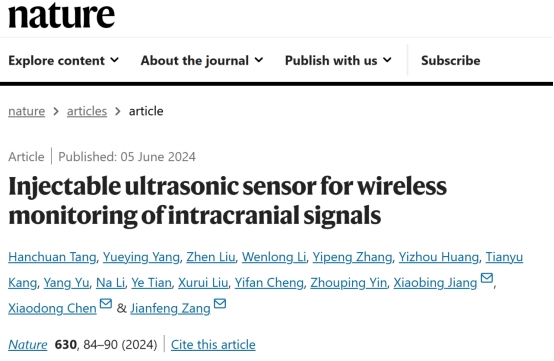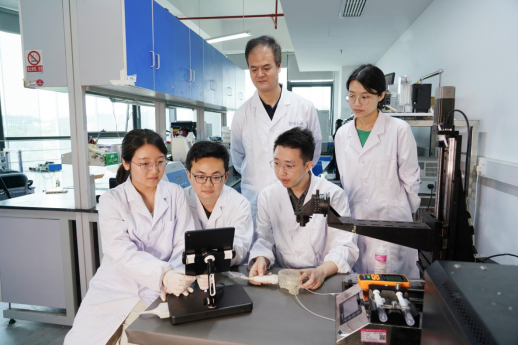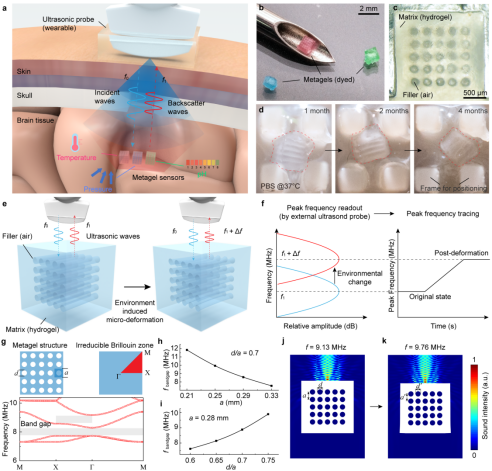The joint team led by Zang Jianfeng from the School of Integrated Circuits, Jiang Xiaobing from the Union Hospital of Tongji Medical College, and Chen Xiaodong from Nanyang Technological University has published their invention in NATURE: Injectable ultrasonic sensor for wireless monitoring of intracranial signals.
Much like a magical “sesame seed,” the sensor conceals great secrets within. When injected into the human body, it can provide doctors with precise physiological parameters.


Prof. Zang Jianfeng’s team
On June 5th, the prestigious international journal NATURE published this innovative research achievement in the interdisciplinary field of medical engineering, titled “Injectable ultrasonic sensor for wireless monitoring of intracranial signals.” The first authors of the paper are Tang Hanchuan, a postdoctoral researcher from the School of Integrated Circuits, Yang Yueying, a doctoral student from the same school, and Liu Zhen, a doctoral student from the Union Hospital. The corresponding authors are Professor Zang Jianfeng from the School of Integrated Circuits, Professor Chen Xiaodong from Nanyang Technological University in Singapore, and Professor Jiang Xiaobing from the Union Hospital. The School of Integrated Circuits is the primary institution responsible for the completion of the paper.
Physiological parameters are indicators that measure the physiological state of the human body, which assists doctors in diagnosing, treating, and monitoring diseases. A key challenge in the field of medical monitoring has always been how to safely and reliably obtain the precise physiological parameters from within the human body.
Currently, the primary clinical method for obtaining data such as intracranial pressure and temperature involves surgically implanting wired and non-degradable electronic probes into the body. To acquire accurate data, these thin yet rigid probes often need to be inserted as deep as several to over ten centimeters. As the probes cannot degrade naturally and require a second surgery for removal, they not only cause repeated pain for patients during implantation and removal, but also pose risks of infections and other complications.

The injectable ultrasonic sensor

The working principle
“The injectable metagel ultrasonic sensor we invented utilizes advanced acoustic metamaterial technology. It’s only 2×2×2 mm3 in size, which is as small as a sesame seed. Due to its minute size, it can be safely injected into the human body, allowing wireless monitoring of changes in intracranial pressure, temperature, pH value, and other physiological parameters through an external ultrasonic probe,” explained Professor Zang Jianfeng. It’s worth mentioning that this novel sensor is made entirely of biodegradable polymer materials. It will degrade naturally in the body within approximately one month, thus avoiding the need for an additional surgery to remove it. This not only reduces the patient’s discomfort, but also significantly lowers the risk of infections.
The core of this microsensor lies in its unique design of the internal structure. Researchers constructed a periodically arranged air channel structure inside the biodegradable hydrogel matrix. When external conditions such as pressure, temperature, and pH change, slight deformations will occur within the gel, which will lead to measurable shifts in the frequency of reflected sound waves. By accurately detecting these frequency changes, it is possible to obtain various physiological parameters, including intracranial pressure, temperature, pH value, and blood flow velocity. Additionally, they have proposed an innovative algorithm that can efficiently separate the coupling effects of multiple factors, such as pressure, temperature, and pH value, by simultaneously analyzing the data of frequency changes from multiple sensors, which enables the comprehensive perception of complex physiological environments.
It is reported that compared with existing commercial wired monitoring devices, the injectable hydrogel ultrasonic sensor is capable of detecting even subtle physiological fluctuations in the human body, such as the changes of minute intracranial pressure caused by breathing movements. Furthermore, it shows significant advantages in terms of energy consumption and heat generation. In the future, this sensor may be applied to more parts of the human body, with the potential to bring a new technological paradigm to intelligent clinical diagnosis and treatment.
Written by: Xiaofei Liu
Edited by: Chang Wen, Peng Yumeng
